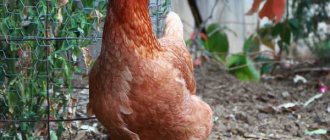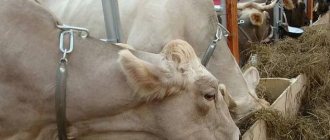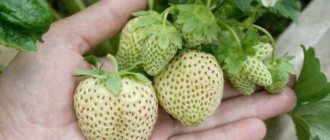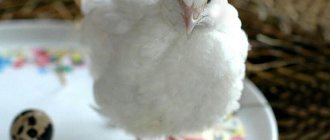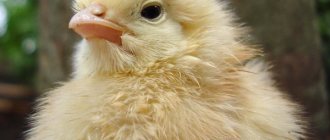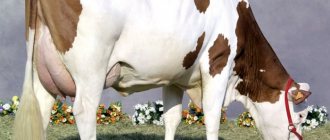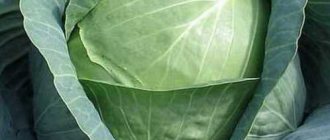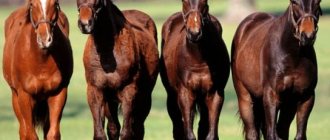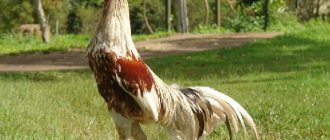Home » Articles about chickens » Dekalb chickens: description of the breed
Dekalb is a hybrid breed of chicken developed in the USA. Selection work was carried out by Dekalb Poltree Research. In the description presented by marketers, the laying hens of the new cross were referred to as “queen chickens.” Birds are characterized by high egg productivity.
Description of the hybrid breed
Currently, the main supplier of Dekalb chickens is the Dutch Animal Husbandry Institute, which merged with Dekalb Poultry Research in 2005. 2 lines are drawn: white and brown. They differ only in the color of their plumage - it can be white or brown. Work to improve the cross continues. The main goal of breeders is to extend the productivity period of laying hens.
Visually, Dekalbs are similar to other egg breeds - they are difficult to distinguish from Leghorns and Highsex. The body of the birds is lean, the bones are light, the body position of the roosters is vertical, the chest is convex. The legs are long, but not distinguished by developed muscles. Paws are yellow. The back is sloping and not wide. The wings are developed. The tail is narrow. The neck is short, the head is small, with a large hanging crest. The earlobes are white. The beak is small, yellowish-red. The eyes are dark.
Appearance
The breed has two varieties of chickens, differing in feather color - white dekalb and brown dekalb. In terms of productivity, both species are identical, but the first type is more widespread.
Description of Dekalb chickens:
- medium-sized, lean body with a light keel;
- the ridge falls to one side, is leaf-shaped and red in color;
- short, wide neck, medium-sized head with a yellow beak and dark orange eyes;
- the chest is convex, the back is straight, the tail is erect;
- the unfeathered part of the paws is dirty yellow.
The peculiarity of the cross is its unpresentable appearance during the period of active egg laying: due to a lack of nutrients, the feather cover looks tattered, as during the molting period. However, this does not in any way affect the quality and taste of the eggs themselves.
The character of Dekalb chickens is docile, not aggressive. They almost never fight with each other, and get along well with other breeds.
Productive qualities
Dekalb chickens have modest meat productivity. The weight of roosters does not exceed 2 kg, chickens - 1.5-1.7 kg. The main advantage of dekalbs is the early onset of puberty and very high egg production. Chickens begin to lay eggs at 4.5-5 months. In industrial conditions, the deadline may come earlier - in 4 months. Chickens reach their maximum performance at 10 months. Throughout the year, laying hens lay up to 330-350 eggs. In pullets, the egg weight is 60-63 g; in mature birds it can be higher. The color of the shell depends on the color - in birds with dark plumage it is brown, in birds with light plumage it is white.
High productivity is explained by the lack of instinct to incubation. A decrease in indicators occurs only during molting, which occurs at 64-68 weeks. You can speed up this period by changing the lighting and feeding regime. Forced molting reduces the non-productive period to 45 days.
What to feed an adult flock
The high egg-laying performance of the described cross largely depends on the nutritional value of its diet. Dekalbs eat quite a bit, so the breeder must wisely balance all the components vital for the birds in a small amount of food.
To this end, experts advise:
- from the moment egg laying begins until its peak, gradually increase the daily portions of food (by about 40%), and also carry out its high-quality change;
- during the period of achieving maximum productivity, ensure that your pets’ food contains an increased composition of amino acids (about 7% more than usual);
- it is preferable to add ground grain to wet mash (its particles should not exceed a diameter of 0.5–3.2 mm);
- give food in 3 doses, leaving about 60% of the daily portion for the second half of the day;
- provide chickens with night snacks by providing additional lighting for 2-3 hours at the right time. This will protect them from underweight;
- ensure that birds have 24-hour access to fresh drinking water. Keep in mind that in hot weather, chickens’ need for drinking doubles;
- regularly mix vitamin and mineral supplements into the feed.
Content
In accordance with the description of the hybrid breed and reviews about it, Dekalb white and brown chickens can easily withstand space restrictions. They can be raised in cages or kept in free range poultry houses. Cage housing is practiced mainly in poultry farms. In private farms, dekalbs are kept in chicken coops with insulated walls. Based on 5 chickens, 1 square meter is enough. m. The floor can be concrete, wood or earthen. Bedding material is laid on top of it - sawdust, dry peat or straw are used. In winter, the thickness of the layer is increased.
Birds do not require additional heating. Due to the tight fit and the absence of cracks, the temperature in the room is maintained at a comfortable temperature for the chickens. To create a healthy microclimate, good ventilation is required. Ventilation through windows and doors leads to cooling of the room and the appearance of drafts. The supply and exhaust system is considered optimal in terms of efficiency and cost of arrangement.
Perches can be single-tiered or multi-tiered. To prevent chickens sitting on the top perch from contaminating the lower ones with excrement, the slats are arranged in the form of a ladder in 30 cm increments. The vertical distance between them is about 40 cm. To simplify cleaning, it is recommended to install a tray under the perches to collect excrement.
Manholes and a walking area are arranged on the south side. The size of the hole for dekalbs is 30x30 cm. To maintain the optimal length of daylight hours, light is provided into the chicken coop - incandescent lamps can be used. They provide air heating, which is an additional benefit in winter. Recommended duration is 14 hours. It is convenient to use automation to automatically turn on and off.
According to the description, Dekalb chickens are productive layers. Nests are installed in the poultry house - 1 for 3 chickens. They are placed above floor level to prevent hypothermia and to protect against rodents.
To clean their feathers, birds require a dry mixture of ash and sand. It is poured into troughs or other containers and installed indoors or in a walking area (under a canopy). The dry mixture is regularly changed with fresh mixture.
The walking area is fenced using a metal mesh. The height of the fence is at least 2 m. So that in summer the birds can hide from the sun or precipitation, it is recommended to install a canopy.
Tendency to disease
Dekalbs have strong immunity, but due to their high productivity they are often exposed to various diseases.
It will also be useful for you to know what chicken leg diseases exist and how to treat them.
Among the most common, veterinarians call:
- Helminthiasis - roundworms and nematode larvae are most often found in birds of this species. A progressive disease is indicated by: refusal of food, weakness, exhaustion, signs of diarrhea, as well as pallor of the comb and earrings. It is important to immediately begin therapeutic measures in relation to the entire livestock, which consists of taking medications. Typically, in such situations, Pirantel, Febtal, Avatek, Filixan, Phenothiazine, Levamisole are mixed into drinks or wet food (the dosage and number of doses can be found in the instructions).
- Vitamin deficiency - occurs due to unbalanced nutrition, severe exhaustion due to continuous egg laying and the presence of a pathogenic environment in the internal organs of the bird. It is typical that this disease is very difficult to diagnose at home, since its symptoms have many similarities with other pathologies. Typically, such a chicken experiences: lethargy, decreased appetite and motor activity, rapid breathing, and attacks of paralysis. To get rid of the disease, you will need a radical adjustment of your diet with the addition of fruits, vegetables and proteins, as well as injections of vitamin and mineral complexes. You should be prepared for the fact that vitamin deficiency is very difficult to treat, and full recovery can occur only after a year.
- Colibacillosis is an acute infectious disease to which chickens up to two months of age are most susceptible. The disease is expressed by a sharp increase in body temperature (up to 44 ° C), wheezing during movements, poor appetite, lethargy and severe thirst. Therapy consists of taking the antibiotics Lexoflon or Enronita.
- Pasteurellosis - spreads to chickens of any age and in most cases ends in death. The onset of the pathology is easily recognized by the onset of fever (body temperature often rises to 43.5 ° C), decreased motor activity, mucous-foamy discharge from the nasal openings, wheezing, difficulty breathing, complete refusal to feed, as well as a red, compacted rash that appears on the ridge. In this case, it is important not to waste time, since the disease develops very quickly. The only way to save the livestock is with antibiotics (Levomycetin, Tetracycline, Avidox, Spelink, Floron, Doxycycline).
- Smallpox - manifests itself as small red spots in the beak area. Subsequently, the smallpox rash spreads throughout the body, and in non-feathered areas merges together, forming elastic growths. The disease can be avoided only through timely vaccination. For this purpose, the following drugs are used: CT Diftosec, Nobilis, FOWL Pox.
- Keratoconjunctivitis - appears under poor living conditions, when the bird lives in close quarters. The onset of pathology is indicated by reddened eyelids and respiratory tracts, difficulty breathing, and swelling. Treatment of the disease involves establishing proper stocking conditions for the stock.
- Cannibalism is a phenomenon that contradicts the calm disposition of Dekalbs, but occurs under conditions of long daylight hours, excessively bright lighting of the chicken coop, or a deficiency of minerals and vitamins in the usual food. Moreover, such attacks of aggression occur more often in females than in males. Pecked areas should be treated with iodine solution and tar.
Did you know? Periodic darkness is important for all birds without exception. At this time, bone tissue is formed, calcium metabolism changes (which is important for the strength of the shell), and immunity factors are produced.
Breeding
According to the description, Dekalb white and brown chickens are crosses. The offspring of hybrid breeds do not retain the characteristics of the parent generation, so there is no point in independent breeding. You will have to buy incubation material or chicks. The lack of maternal instinct in chickens will not allow them to be used as brood hens - an incubator will be required. Incubation duration is 3 weeks. 75-80% of chicks hatch from a laid clutch. The survival rate of young animals is very high – up to 100%.
Dried chickens are transferred to a brooder, where an optimal microclimate is maintained:
- high temperature (at the initial stage: +30°C);
- continuous illumination;
- moderate humidity (60-70%).
To make it easier to maintain hygiene, a mesh floor is installed, and a tray is placed underneath to collect excrement. At first, the chickens are fed 6 times a day, gradually the frequency of feedings is reduced. It is advisable to use ready-made complete feed - the norm for 1 chicken in the first 5 days is 15 g, gradually increasing. Pre-start feed with a high protein content can be replaced with a boiled egg, squeezed low-fat cottage cheese and cereal. In the first days, the chicks are given boiled water at room temperature.
History of cross breeding
Dekalb White appeared on the agricultural market relatively recently, but during its existence it managed to gain good authority among farmers of various types.
Did you know? Every year, the world's population eats about 567 billion chicken eggs. At the same time, German residents alone consume almost 16 billion eggs annually, which is an average of 200 eggs for every German
.
About a hundred years ago, when breeders of a well-known bird in the United States of America tried to convey information about the merits of their new development to the whole world, advertising specialists called these birds “the princesses of poultry farming.”
Over time, the promising slogan was fully justified - despite the youth of the breed, it quickly spread throughout the world and, moreover, occupied a leading position in egg productivity ratings. It was especially preferred by owners of large poultry production.
Today, developers continue to improve the positive qualities of the cross, focusing on increasing egg mass, and currently it is Dekalb chickens that give record levels of egg productivity.
Feeding
Laying hens need an increased supply of protein and minerals - this must be taken into account when preparing the diet. For industrial fattening, age-appropriate complete feed is used. They contain all the necessary components. In small farms, mixtures are most often prepared independently - such fattening is cheaper.
Approximate composition:
- wheat, corn, barley – 20, 40 and 8%, respectively;
- sunflower meal – 11%;
- cake – 9%;
- shell – 4.6%;
- feed yeast and chalk – 3% each;
- fish and herbal meal – 4% each;
- table salt – 0.4%.
The prepared premix is added to the mixture in accordance with the manufacturer's recommendations.
Due to their accelerated metabolism, it is recommended to feed dekalbs 3 times a day. In addition to the dry mixture, the birds are given vegetables, fresh grass and tops. In winter, greens are replaced with grass flour, clover and legume-cereal hay, and pine needles. It is useful to give boiled legumes and sprouted grains.
A necessary nutritional component is animal protein (dairy products, fish and meat waste). Wet mashes are prepared based on grains, vegetables, and herbs - they are quickly digested and saturate well. This food spoils quickly, so it is prepared in small portions, the leftovers are thrown away, and the feeders are washed.
Incubation
The lack of brooding instinct causes the young to be bred in an incubator or under laying hens of other breeds.
Eggs laid in no more than 5 days, without defects, are suitable for placing in the incubator. Preliminary disinfection with Ecocide or manganese solution is required. The incubation period is 20 days. In this case, overheating is not allowed.
Table of temperature and humidity modes
| Period |
